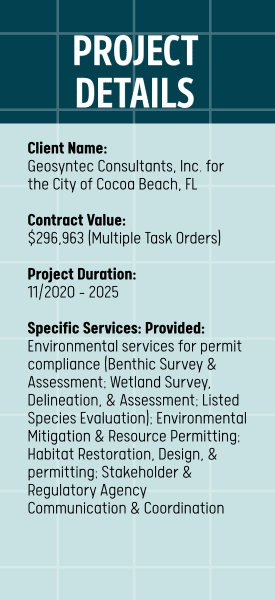In a joint effort, Applied Ecology, Inc. (AEI) and Geosyntec Consultants, Inc. (Geosyntec) provided environmental, permitting, geotechnical, and engineering services to restore the muck site identified as a priority by the Brevard County Save Our Indian River Lagoon Project Plan. Due to increasing costs and partial funding, this muck management project located within a protected water body required an innovative solution. After considering multiple alternatives, muck capping was identified as the best solution to manage the 160-acre muck deposit in the Banana River Lagoon, located near the Cocoa Beach Golf Course and High School.
Applied Ecology completed all the ecological and water quality assessment work to evaluate and prioritize alternative muck management strategies based on cost and ecological benefits. The assessments included the entire project area including a sub-bottom survey of the muck deposit area, the adjacent shorelines, and the proposed dredge spoil management area to identify and map any living resources including Submerged Aquatic Vegetation (SAV) and other listed species. The extent of wetlands and other surface waters occurring within the project area were identified and delineated in accordance with § 62-340 Florida Administrative Code as well as jurisdictional authority held by the United States Army Corps of Engineers (USACE). The results of the assessment were used to estimate potential impacts of alternative strategies, support permit application packages, and provide a baseline of benthic conditions from which to evaluate restoration success.
After the proposed restoration alternatives were formulated, AEI assisted with a peer-review and restoration evaluation of proposed engineering designs, developing a matrix of costs and ecological benefits for consideration as well as permitting concerns, long-term maintenance, and monitoring needs. When muck capping was identified as the number one strategy, AEI worked closely with our regulatory agencies to prepare the application packages for this innovative, first-ever, muck capping project in the Indian River Lagoon, a designated State Aquatic Preserve and National Estuary.
AEI assessed distribution and density (percent cover) of benthic resources and essential fish habitat (EFH) within the site to satisfy permitting requirements. Submerged aquatic vegetation (SAV) surveys were conducted along ~ 20,850 linear feet of transects in accordance with the methodology described by the USACE and SJRWMD. The lateral extent of seagrass beds within the site were delineated using sub-meter accuracy GPS Units. Benthic characteristics, including a description of sediment conditions, depth, bathymetric features, and other resources were recorded and summarized for each transect. After the application package was submitted, AEI met regularly with state and federal regulatory agencies to negotiate surface water/wetland impacts, Threatened and Endangered Species (t/e) species affect determinations, potential specific conditions to the permit/authorizations, and compensatory mitigation/restoration activities. Additionally, AEI established protocols accepted by the agencies to monitor both water quality and habitat restoration success as part of the compliance requirements.
Due to the collaborative and innovative approach led by the project team, both federal and state permit authorizations were issued, making this the first capping project to be permitted in the Indian River Lagoon, opening the door for other innovative in-water ecological restoration projects.
AEI assisted with community outreach, presenting to important decision-making committees like the Brevard County Save Our Indian River Lagoon (SOIRL) oversight committee, City Commission, and City Sustainability Board. AEI prepared the presentation materials (PowerPoint/ArcGIS StoryMap, etc.) necessary to facilitate the meetings and communicate the project to the public.

